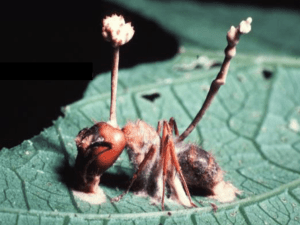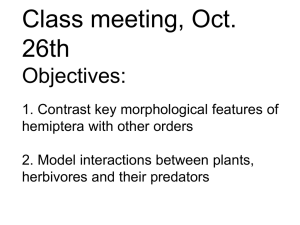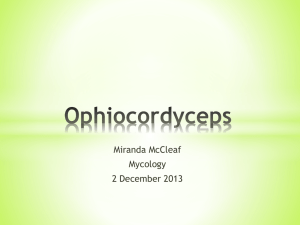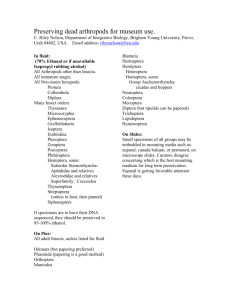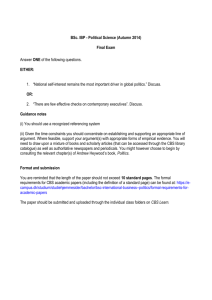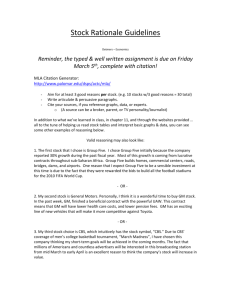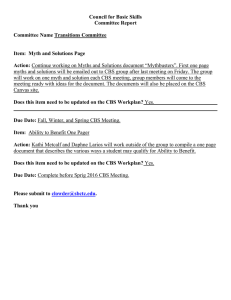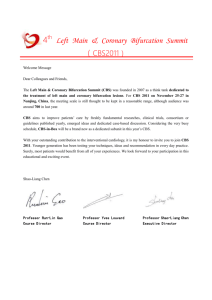The phylogenetic placement of hypocrealean insect pathogens in the genus Polycephalomyces:
advertisement
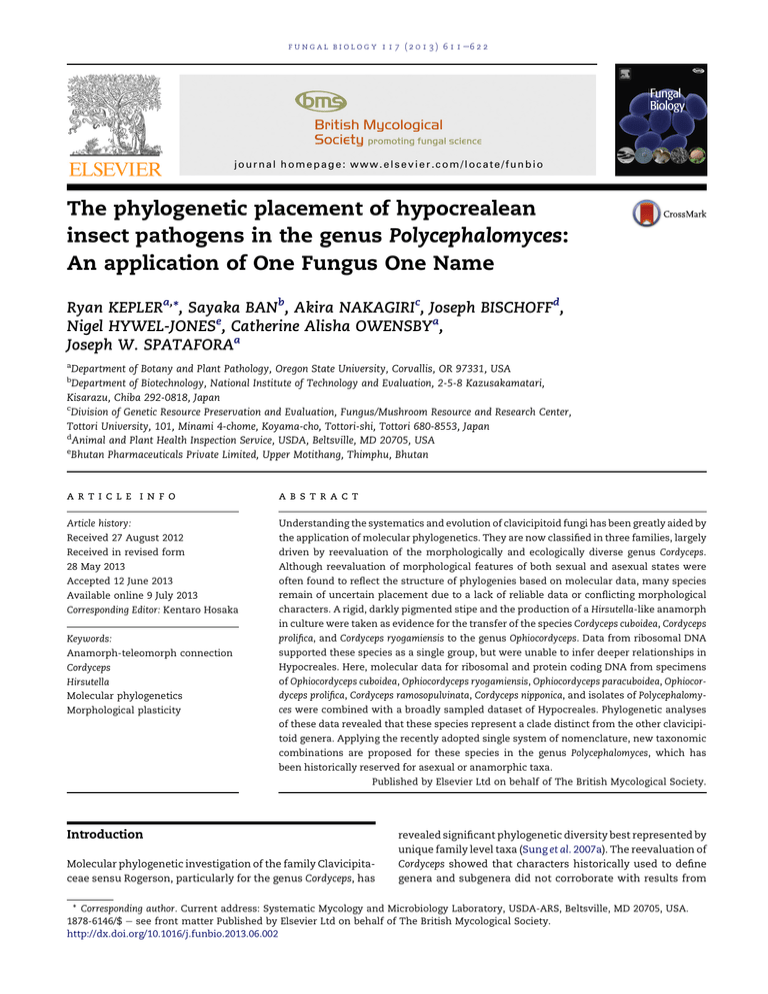
f u n g a l b i o l o g y 1 1 7 ( 2 0 1 3 ) 6 1 1 e6 2 2 journal homepage: www.elsevier.com/locate/funbio The phylogenetic placement of hypocrealean insect pathogens in the genus Polycephalomyces: An application of One Fungus One Name Ryan KEPLERa,*, Sayaka BANb, Akira NAKAGIRIc, Joseph BISCHOFFd, Nigel HYWEL-JONESe, Catherine Alisha OWENSBYa, Joseph W. SPATAFORAa a Department of Botany and Plant Pathology, Oregon State University, Corvallis, OR 97331, USA Department of Biotechnology, National Institute of Technology and Evaluation, 2-5-8 Kazusakamatari, Kisarazu, Chiba 292-0818, Japan c Division of Genetic Resource Preservation and Evaluation, Fungus/Mushroom Resource and Research Center, Tottori University, 101, Minami 4-chome, Koyama-cho, Tottori-shi, Tottori 680-8553, Japan d Animal and Plant Health Inspection Service, USDA, Beltsville, MD 20705, USA e Bhutan Pharmaceuticals Private Limited, Upper Motithang, Thimphu, Bhutan b article info abstract Article history: Understanding the systematics and evolution of clavicipitoid fungi has been greatly aided by Received 27 August 2012 the application of molecular phylogenetics. They are now classified in three families, largely Received in revised form driven by reevaluation of the morphologically and ecologically diverse genus Cordyceps. 28 May 2013 Although reevaluation of morphological features of both sexual and asexual states were Accepted 12 June 2013 often found to reflect the structure of phylogenies based on molecular data, many species Available online 9 July 2013 remain of uncertain placement due to a lack of reliable data or conflicting morphological Corresponding Editor: Kentaro Hosaka characters. A rigid, darkly pigmented stipe and the production of a Hirsutella-like anamorph in culture were taken as evidence for the transfer of the species Cordyceps cuboidea, Cordyceps Keywords: prolifica, and Cordyceps ryogamiensis to the genus Ophiocordyceps. Data from ribosomal DNA Anamorph-teleomorph connection supported these species as a single group, but were unable to infer deeper relationships in Cordyceps Hypocreales. Here, molecular data for ribosomal and protein coding DNA from specimens Hirsutella of Ophiocordyceps cuboidea, Ophiocordyceps ryogamiensis, Ophiocordyceps paracuboidea, Ophiocor- Molecular phylogenetics dyceps prolifica, Cordyceps ramosopulvinata, Cordyceps nipponica, and isolates of Polycephalomy- Morphological plasticity ces were combined with a broadly sampled dataset of Hypocreales. Phylogenetic analyses of these data revealed that these species represent a clade distinct from the other clavicipitoid genera. Applying the recently adopted single system of nomenclature, new taxonomic combinations are proposed for these species in the genus Polycephalomyces, which has been historically reserved for asexual or anamorphic taxa. Published by Elsevier Ltd on behalf of The British Mycological Society. Introduction Molecular phylogenetic investigation of the family Clavicipitaceae sensu Rogerson, particularly for the genus Cordyceps, has revealed significant phylogenetic diversity best represented by unique family level taxa (Sung et al. 2007a). The reevaluation of Cordyceps showed that characters historically used to define genera and subgenera did not corroborate with results from * Corresponding author. Current address: Systematic Mycology and Microbiology Laboratory, USDA-ARS, Beltsville, MD 20705, USA. 1878-6146/$ e see front matter Published by Elsevier Ltd on behalf of The British Mycological Society. http://dx.doi.org/10.1016/j.funbio.2013.06.002 612 molecular data. Current taxonomic concepts for the clavicipitoid fungi now recognize three families: Clavicipitaceae sensu stricto, Cordycipitaceae and Ophiocordycipitaceae. Traits such as orientation of perithecia and morphology of ascospores, which previously were used to define subgeneric boundaries, were distributed across all three families. Morphological characters that were most consistent with the resulting molecular phylogeny and that correlated with generic boundaries included texture and colour of the stroma as well as ecological niche (Sung et al. 2007a). The genus Cordyceps s.s. in Cordycipitaceae contains species with a fleshy texture and brightly coloured stromata and tends to attack hosts in leaf litter or shallow soil. The genus Metacordyceps in Clavicipitaceae contains species producing a stroma with a firm, fibrous texture and predominantly green, pallid or lilac coloration, which darkens to a purple or black upon bruising or drying (Sung et al. 2007a; Kepler et al. 2012a). Ophiocordyceps in Ophiocordycipitaceae comprises fungi producing a rigid, pliant or wiry stipe that is darkly coloured and are typically found on hosts buried in soil or in rotting wood. Although these characters correspond well to clades, exceptions occur due to the homoplasious distributions of several character states (e.g., brightly pigmented clava of Ophiocordyceps nutans attacking adult hemipterans). Anamorph morphologies were also demonstrated to have varying degrees of phylogenetic informativeness (Sung et al. 2007a). Species in the genus Metacordyceps produce anamorphs in the genera Pochonia and Metarhizium, as well as green-spored forms of Nomuraea, whereas pink or lilac forms of Nomuraea can be found in Ophiocordycipitaceae (Sung et al. 2007a; Kepler et al. 2012a). Ophiocordycipitaceae are also associated with Hymenostilbe and Hirsutella anamorphs, which are produced on stromata that often concurrently or subsequently give rise to perithecia. Anamorphic forms restricted to Cordycipitaceae include Lecanicillium, Isaria and Beauveria associated with Cordyceps s.s. and Gibellula, associated with Torrubiella (Sung et al. 2007a). Although these anamorphic forms are fairly indicative of family and genus level associations, examples do exist of broadly distributed anamorph genera (e.g., residual Verticillium, Zare et al. 2000; Paecilomyces, Luangsa-ard et al. 2004), which can complicate the placement of asexually reproductive taxa in the modern phylogenetic classification. Recent hypotheses concerning evolution of host affiliation support arthropod pathogens as being an ancestral ecology for many lineages of clavicipitoid fungi with dynamic host shifts among diverse insect groups and repeated jumping onto plants and other fungi (Spatafora et al. 2007; Sung et al. 2008; Kepler et al. 2012b). For example, although pathogens of other fungi can be found throughout clavicipitoid fungi, those attacking false truffles in the genus Elaphomyces are restricted to Elaphocordyceps of Ophiocordycipitaceae (Sung et al. 2007a) and species infecting the sclerotia of Claviceps are restricted to Tyrannicordyceps (Kepler et al. 2012b) of Clavicipitaceae. Pathogens of spiders are most commonly encountered in Cordycipitaceae in the genera Torrubiella and Cordyceps, but insect hosts tend be more broadly distributed with Coleoptera, Lepidoptera and Hemiptera found in all three families. Polycephalomyces Kobayasi is an anamorph genus with an unconfirmed phylogenetic placement and teleomorph affinity that has proven difficult to incorporate into evolutionary R. Kepler et al. hypotheses of clavicipitoid fungi. This confusion stems from a long history of conflicting hypotheses regarding host substrate and teleomorph affinities. Species of Polycephalomyces have often been found associated with the stromata of entomopathogenic Cordyceps (Massee 1895; Kobayasi 1941). However, it has remained unclear whether Polycephalomyces spp. represent anamorphic expressions of Cordyceps spp. or are hyperparasites of the latter (Seifert 1985). The type species, Polycephalomyces formosus, is synnematous, determinate, and produces small obovoid to ellipsoidal conidia (A-conidia) in a mucous-like matrix (Seifert 1985). The convergent nature of some characters across all three families of clavicipitoid fungi leaves a considerable number of taxa of uncertain placement, resulting in the residual Cordyceps s.l. of Sung et al. (2007a). Morphological and ecological character states for these taxa were either lacking or inconclusive and no molecular sequence data were available to test character state homologies. Ban et al. (2009) used the large subunit of nuclear ribosomal RNA (LSU) and the complete span of the internal transcribed spacer region (ITS) to address the phylogenetic placement of four species of residual Cordyceps s.l., including Cordyceps alboperitheciata Kobayasi & Shimizu, Ophiocordyceps cuboidea (Kobayasi & Shimizu) S. Ban, Sakane & Nakagiri, Ophiocordyceps ryogamiensis (Kobayasi & Shimizu) G.H. Sung, J.M. Sung, Hywel-Jones & Spatafora, and Oryogamiensis prolifica (Kobayasi) S. Ban, Sakane & Nakagiri. They also successfully cultured the anamorphic forms from fresh material. The molecular data showed these species formed a well-supported clade sister to the species Cordyceps ramosopulvinata Kobayasi & Shimizu and Cordyceps kanzashiana Kobayasi & Shimizu. Furthermore, a cryptic species was uncovered (Ophiocordyceps paracuboidea S. Ban, Sakane & Nakagiri) and the name C. alboperitheciata was found to be synonymous with O. cuboidea. However, genus and family level relationships for this group remained unsupported and classification of these species within the phylogenetic framework for clavicipitoid fungi was not possible using molecular data alone. The anamorphic forms were described as Hirsutella-like and this was used as justification to move these taxa into the genus Ophiocordyceps. In this paper we expand sampling of molecular data for of O. cuboidea, O. ryogamiensis, O. paracuboidea and O. prolifica sampled by Ban et al. (2009). We also expand the sampling to include Cordyceps nipponica Kobayasi, Cordyceps pleuricapitata Kobayasi and Shimizu, and the anamorph species P. formosus and Blistum tomentosum, a species previously included in Polycephalomyces. When incorporated into a multigene dataset including representatives from six hypocrealean families, including all clavicipitoid lineages (Sung et al. 2007a), we find these taxa are not supported as members of Ophiocordyceps, but rather represent a unique taxon that is not placed in any existing genus or family of teleomorphs. Consistent with the application of a single system of nomenclature to a clade of fungi regardless of life history states (Taylor 2011; Hawksworth et al. 2011), we emend the genus Polycephalomyces to include teleomorphs C. kanzashiana, C. ramosopulvinata, C. nipponica, O. cuboidea, O. ryogamiensis, O. paracuboidea and O. prolifica, and discuss its phylogenetic relationship to other hypocrealean fungi. We also conclude B. tomentosum belongs in Polycephalomyces. The phylogenetic placement of hypocrealean insect pathogens in the genus Polycephalomyces Materials and methods 613 UK). Sequencing reactions were performed at University of Washington High-Throughput Sequencing Solutions (Seattle, WA) with the primers used for the initial amplifications. Specimen collection Phylogenetic analyses Tissue from cultures of Ophiocordyceps cuboidea, Ophiocordyceps ryogamiensis, Ophiocordyceps paracuboidea and Oryogamiensis prolifica sampled in the Ban et al. (2009) paper were resampled from stocks maintained at the National Institute of Technology and Evaluation Biological Resource Center (NBRC). Material from cultures of Cordyceps pleuricaptiata, also maintained at NBRC, was included. In addition fresh material was collected from field sites in Japan during the months of JuneeAug. in the years 2007 and 2008. Upon collection, specimens were cleaned of dirt and placed in a wax paper bag, a piece of tissue was removed and placed in CTAB buffer for DNA extraction and later air dried for herbarium storage. Ascospores of Thai material were discharged onto PDA and germinated in 24e36 h at ambient field temperatures (20e32 C). Part-spores of Cordyceps ramosopulvinata were discharged onto Sabouraud Dextrose Agar and germinated at w25 C. These isolations were then sent to Rutgers University where they were subcultured onto PDA and kept at 24e27 C in continuous light (fluorescent lights). (See Table 1 for further details on isolates used in this study.) DNA extraction, PCR and sequencing Tissue received an initial grinding by power drill with an Eppendorf pestle in 50 ml CLS-VF buffer from the FastDNA Spin Kit (MP Biomedicals, Salon, OH). Four hundred microlitres of CLS-VF was then added to the ground tissue in a FastDNA lysing matrix A tube and ground further with the fast prep machine for two cycles, 20 s each. Cell lysis was enhanced by soaking for 20 min in a water bath at 60 C. Tissue was then separated from the supernatant by centrifugation for 10 min at 14 000 rpm. Four hundred microlitres of supernatant was then removed for further cleaning with centrifugation at 14 000 rpm for 20 min in 500 ml chloroform:isoamyl alcohol (24:1). Cleaned and concentrated DNA was then obtained from 300 ml of the top layer of liquid after chloroform:isoamyl centrifugation with the GeneCleanIII Kit following the manufacturers protocol and eluting from glass milk in the final step with 30 ml of water. PCR methods were used to amplify a total of six nuclear loci for each specimen. As an initial quality control step, and to serve as a voucher for barcoding efforts, the complete span of the internal transcribed spacer region of ribosomal DNA (ITS15.8s-ITS2) was amplified and sequenced. A BLAST search of the GenBank database was performed to ensure that DNAs obtained were not from contaminants outside of Hypocreales. After passing quality control measures, five nuclear loci were amplified and sequenced for phylogenetic analysis: SSU and LSU, elongation factor 1a (TEF), and the largest and second largest subunits of RNA polymerase II (RPB1 and RPB2, respectively). Primer information and PCR cycle parameters are described in Kepler et al. (2012a) unless otherwise noted. PCR reactions were performed in a MyCycler thermocycler (BioRad, Hercules, CA) using either MasterAmp 2X PCR premix E (Epicenter, Madison WI) and GenScript Taq polymerase or PuReTaq Ready-ToGo PCR Beads (GE Healthcare, Little Chalfont, Buckinghamshire, Processing of raw sequence reads and construction of contigs was performed using CodonCode Aligner, version 2.0.6 (Dedham, MA). A dataset was then assembled with representative species throughout Hypocreales in the families Hypocreaceae, Nectriaceae and Bionectriaceae in Hypocreales, as well as the outgroup taxa Glomerella cingulata and Verticillium dahliae. For nearly all specimens examined, at least three of the five genes sought were obtained. Data for Cordyceps kanzashiana included only SSU and LSU. GenBank and specimen voucher information is provided in Table 1. MAFFT version 6 (Katoh et al. 2002; Katoh & Toh 2008) was used to obtain an initial alignment that was then improved by visual examination with the program BioEdit version 7.05 (Hall 1999). Ambiguously aligned regions were identified with the default settings of Gblocks server (http://molevol.cmima.csic.es/castresana/Gblocks_server.html) (Castresana 2000; Talavera & Castresana 2007) and excluded from phylogenetic analyses and gaps were treated as missing data. The final dataset contained sequences from 153 specimens. After exclusion of ambiguously aligned sites there were 1021 nucleotides for SSU, 814 for LSU, 920 for TEF, 641 for RPB1 and 1111 for RPB2. The total length of aligned sequences was 4507 bp. Conflict between loci was examined with the program compat.py (Kauff & Lutzoni 2002). Maximum Likelihood (ML) estimation of phylogeny was performed with RAxML version 7.0.4 (Stamatakis 2006) with 500 rapid bootstrap replicates on a concatenated dataset containing all five genes. Eleven data partitions were defined for the final combined dataset, one each for SSU and LSU plus nine for each of the three codon positions for the protein coding genes TEF, RPB1, and RPB2. The CAT-GAMMA model of nucleotide substitution was applied to each partition during the rapid bootstrapping phase and the GTR-GAMMA model of nucleotide substitution was specified for the final likelihood tree as suggested by the program manual for large datasets. Bayesian estimation of phylogenetic relationships was conducted with the program Mr. Bayes v3.1 (Ronquist & Huelsenbeck 2003). The same eleven data partitions were applied with the GTR þ I þ G nucleotide substitution model used for all gene partitions. Two runs were conducted simultaneously, each with four chains for ten million generations. Each chain was sampled every 100 generations, and trees saved with branch length information every 500 generations. After the analysis finished, each run was examined with the program Tracer v1.5 (Drummond & Rambaut 2007) to determine burn-in and confirm that both runs had converged. Summary of the model parameters was determined with the sump command. A strict consensus tree with branch lengths and posterior probabilities was then obtained with the sumt command. The same burnin value was used for both sump and sumt commands. Results ML and Bayesian analyses confirmed Cordyceps ramosopulvinata, Cordyceps nipponica, Cordyceps kanzashiana Ophiocordyceps 614 R. Kepler et al. Table 1 e Specimen information for materials used in this study. Taxon Host Voucher# GenBank accession numbers ITS Akanthomyces novoguineensis Aphysiostroma stercorarium Aschersonia cf. badia Aschersonia confluence Aschersonia placenta Balansia epichlo€e Balansia henningsiana Balansia pilulaeformis Bionectria ochroleuca Claviceps fusiformis Claviceps paspali Claviceps purpurea Claviceps purpurea Conoideocrella luteorostrata Conoideocrella luteorostrata Conoideocrella tenuis Conoideocrella tenuis Conoideocrella tenuis Cordyceps bifusispora Cordyceps brongniartii Cordyceps cardinalis Cordyceps coccidioperitheciata Cordyceps confragosa Cordyceps gunnii Cordyceps kyusyu€ensis Cordyceps militaris Cordyceps cf. ochraceostromata Cordyceps pluricapitata Cordyceps pluricapitata Cordyceps scarabaeicola Cordyceps tuberculata Cosmospora coccinea Elaphocordyceps japonica Elaphocordyceps ophioglossoides Elaphocordyceps subsessilis Engyodontium aranearum Epichlo€e typhina Gibellula sp. Glomerella cingulata Glomerella cingulata Haptocillium sinense Hirsutella sp. Hirsutella sp. Hydropisphaera peziza Hypocrella discoidea Hypocrea lutea Hypocrea rufa Isaria coleopterorum Isaria farinosa Isaria tenuipes Lecanicillium attenuatum Lecanicillium psalliotae Mariannaea elegans var. punicea Mariannaea pruinosa Metacordyceps atrovirens Metacordyceps chlamydosporia Metacordyceps indigotica Metacordyceps indigotica Metacordyceps khaoyaiensis Metacordyceps khaoyaiensis Metacordyceps kusanagiensis Metacordyceps liangshanensis Araneae Cow dung Hemiptera Hemiptera Hemiptera Poaceae Poaceae Poaceae Bark Poaceae Poaceae Poaceae Poaceae Hemiptera Hemiptera Hemiptera Hemiptera Hemiptera Lepidoptera Lepidoptera Lepidoptera Araneae Hemiptera Lepidoptera Lepidoptera Lepidoptera Lepidoptera Hemiptera Hemiptera Coleoptera Lepidoptera Hymenochaetales Eurotiales Eurotiales Eurotiales Araneae Poaceae Araneae Rosaceae Rosaceae Nematoda Hemiptera Hemiptera Bark Hemiptera Wood Bark Coleoptera Lepidoptera Lepidoptera Leaf litter Soil Soil Lepidoptera Coleoptera Nematoda Lepidoptera Lepidoptera Lepidoptera Lepidoptera Coleoptera Lepidoptera NHJ 11923 ATCC 62321 BCC 7016 BCC 7961 BCC 7869 AEG 96-15a GAM 16112 AEG 94-2 CBS 114056 ATCC 26019 ATCC 13892 GAM 12885 SA cp11 NHJ 11343 NHJ 12516 NHJ 345.01 NHJ 6293 NHJ 6791 EFCC 5690 BCC 16585 OSC 93610 NHJ 6709 CBS 101247 OSC 76404 EFCC 5886 OSC 93623 ARSEF 5691 NBRC 100745 NBRC 100746 ARSEF 5689 OSC 111002 CBS 114050 OSC 110991 OSC 106405 OSC 71235 CBS 309.85 ATCC 56429 NHJ 13158 FAU 513 CBS 114054 CBS 567.95 OSC 128575 NHJ 12525 CBS 102038 BCC 8237 ATCC 208838 CBS 114374 CBS 110.73 CBS 240.32 ARSEF 5135 CBS 402.78 CBS 532.81 CBS 239.56 ARSEF 5413 TNM F10184 CBS 101244 TNS F18553 TNS F18554 BCC 12687 BCC 14290 TNS F18494 EFCC 1523 JN049839 JN049841 JN049842 JN049848 JN049815 JN049816 JN049817 JN049818 U57669 JN049859 JN049860 JN049862 JN049863 JN049867 JN049843 JN049865 JN049836 JN049822 JN049825 JN049849 JN049827 JN049830 JN049831 JN049824 JN049844 AJ292391 JN049832 JN049864 DQ286202 AJ292417 JN049845 SSU LSU TEF RPB1 RPB2 EU369095 AF543769 DQ372091 DQ372100 EF469121 EF468949 AY545723 AF543764 AY489684 DQ522539 U32401 AF543765 EF469122 EF468995 EF468994 EU369111 EU369112 EU369113 EF468952 JF415951 AY184974 EU369110 AF339604 AF339572 EF468960 AY184977 EF468964 KF049606 KF049607 AF339574 DQ522553 AY489702 DQ522547 AY489691 EF469124 AF339576 U32405 EU369100 U48427 AF543762 AF339594 EF469126 EF469125 AY489698 EU369032 AF543792 DQ384941 DQ384947 EF469074 EU369013 AF543782 DQ384969 DQ384976 EF469056 EF468743 AY489610 DQ522319 AY489611 DQ522320 DQ522321 AF543778 EF469058 EF468801 EF468800 EU369030 EU369029 EU369028 EF468746 JF416009 EF469059 EU369025 DQ522359 AY489616 EF468754 DQ522332 EF468759 KF049679 KF049680 DQ522335 DQ522338 AY489629 DQ522330 AY489618 EF469061 DQ522341 AF543777 EU369020 AF543772 AF543773 DQ522343 EF469064 EF469063 AY489625 DQ384977 AF543781 AY489621 JF416028 JF416019 JF416020 EF468782 EF469067 JF416021 DQ522351 EU369052 AY489633 DQ385009 DQ384998 EF469085 EF468851 AY489643 DQ522365 DQ842031 DQ522366 DQ522367 AY489648 EF469087 EF468906 EF468905 EU369072 EF469103 DQ452460 DQ452465 EF469104 EF468908 DQ522413 DQ522414 DQ522415 JN049840 AY624177 AY624178 AY624196 AJ292434 JN049846 AY624201 JN049826 JN049882 JN049821 JN049874 JN049875 JN049868 JN049869 JN049873 AF543768 AY489694 JF415965 JF415958 AF339614 AF339609 AY526489 AY184979 JF415950 DQ522544 JF415953 JF415952 JF415954 EF468961 AY545727 AF543788 AY489716 U17402 U47826 AF543789 EF469075 EF468850 EF468849 EU369045 EU369044 EU369046 EF468806 JF415967 AY184963 EU369042 AF339555 AF339522 EF468813 AY184966 EF468819 KF049624 KF049625 AF339524 DQ518767 AY489734 DQ518761 AY489723 EF469077 AF339526 U17396 EU369037 U48428 AF543786 AF339545 EF469079 EF469078 AY489730 DQ384937 AF543791 AY489726 JF415988 JF415979 JF415980 AF339565 AF339560 JF415981 AY184968 JF415966 DQ518758 JF415968 JF415969 JF415970 JF415971 JF415972 EF468814 DQ522327 JF416010 JF416011 JF416012 JF416013 JF416014 EF468755 EU369068 EU369069 EF468854 JN049885 EF469088 EU369067 DQ522407 AY489650 EF468863 DQ522377 EF468867 KF049642 KF049643 DQ522380 DQ522384 AY489667 DQ522375 AY489652 EF469090 DQ522387 AY489653 EU369057 DQ858454 AY489659 DQ522389 EF469093 EF469092 AY489661 DQ385000 AY489662 AY489656 JN049903 JN049895 JN049896 EF468888 EF469096 JN049897 DQ522397 JN049884 DQ522372 JN049886 JN049887 JN049888 JN049889 JN049890 DQ522416 DQ522417 EF469105 EF468946 EU369088 EU369087 EU369089 EF468909 JF415991 EF469106 EU369086 DQ522466 DQ522426 EF468917 AY545732 EF468921 KF049667 KF049668 DQ522431 DQ522435 DQ522438 DQ522428 DQ522429 EF469108 DQ522439 DQ522440 EU369077 DQ858455 DQ522441 DQ522443 EF469110 EF469111 DQ522444 DQ452461 DQ522446 EF692510 JF416006 JF415999 JF416000 EF468935 EF469112 JF416001 DQ522451 DQ522424 JF415992 JF415993 EF468918 The phylogenetic placement of hypocrealean insect pathogens in the genus Polycephalomyces 615 Table 1 e (continued ) Taxon Metacordyceps liangshanensis Metacordyceps martialis Metacordyceps martialis Metacordyceps martialis Metacordyceps owariensis Metacordyceps pseudoatrovirens Metacordyceps sp. Metacordyceps taii Metacordyceps yongmunensis Metacordyceps yongmunensis Metarhizium album Metarhizium anisopliae Metarhizium flavoviride Metarhizium sp. Metarhizium sp. Metarhizium sp. Metarhizium sp. Moelleriella mollii Moelleriella schizostachyi Myriogenospora atramentosa Nectria cinnabarina Nectria sp. Nomuraea cylindrosporae Nomuraea cylindrosporae Nomuraea rileyi Ophiocordyceps acicularis Ophiocordyceps agriotidis Ophiocordyceps aphodii Ophiocordyceps brunneipunctata Ophiocordyceps entomorrhiza Ophiocordyceps gracilis Ophiocordyceps heteropoda Ophiocordyceps longissima Ophiocordyceps nigrella Ophiocordyceps ravenelii Ophiocordyceps rhizoidea Ophiocordyceps sinensis Ophiocordyceps sobolifera Ophiocordyceps longissima Ophiocordyceps stylophora Ophiocordyceps unilateralis Ophiocordyceps variabilis Ophionectria trichospora Orbiocrella petchii Orbiocrella petchii Paecilomyces carneus Paecilomyces lilacinus Paecilomyces marquandii Paecilomyces carneus Pochonia bulbillosa Pochonia chlamydosporia Pochonia gonioides Pochonia parasiticum Pochonia rubescens Polycephalomyces cuboidea Polycephalomyces cuboidea Polycephalomyces formosus Polycephalomyces kanzashiana Polycephalomyces nipponica Polycephalomyces nipponica Polycephalomyces nipponica Host Lepidoptera Lepidoptera Lepidoptera Lepidoptera Hemiptera Coleoptera Coleoptera Lepidoptera Lepidoptera Lepidoptera Hemiptera Coleoptera Hemiptera Coleoptera Coleoptera Coleoptera Coleoptera Hemiptera Hemiptera Poaceae Betulaceae Plant Hemiptera Hemiptera Lepidoptera Coleoptera Coleoptera Coleoptera Coleoptera Coleoptera Lepidoptera Hemiptera Hemiptera Lepidoptera Lepidoptera Isoptera Lepidoptera Hemiptera Hemiptera Coleoptera Hymenoptera Diptera Plant Hemiptera Hemiptera Sand dune Nematoda Soil Soil Plant Nematoda Nematoda Rotifera Nematoda Coleoptera Coleoptera Coleoptera Hemiptera Neuroptera Neuroptera Neuroptera Voucher# EFCC 1452 TTZ070716-04 EFCC 6863 HMAS 197472(S) NBRC 33258 TNSF 16380 HMAS 199601 ARSEF 5714 EFCC 2131 EFCC 2135 ARSEF 2082 ARSEF 3145 ARSEF 2037 HMAS 199590 HMAS 199592 HMAS 199596 HMAS 199603 BCC 7963 BCC 1985 AEG 96-32 CBS 114055 CBS 478.75 RCEF 3632 TNS 16371 CBS 806.71 OSC 128580 ARSEF 5692 ARSEF 5498 OSC 128576 KEW 53484 EFCC 8572 EFCC 10125 EFCC 6814 EFCC 9247 OSC 110995 NHJ 12522 EFCC 7287 KEW 78842 EFCC 6814 OSC 111000 OSC 128574 ARSEF 5365 CBS 109876 NHJ 5318 NHJ 6209 CBS 239.32 CBS 431.87 CBS 182.27 CBS 239.32 CBS 145.70 CBS 504.66 CBS 891.72 ARSEF 3436 CBS 464.88 TNS-F-18487 NBRC 101740 ARSEF 1424 BCC 18108 BCC 1881 BCC 1682 GenBank accession numbers ITS SSU LSU TEF EF468962 JF415955 EF468815 JF415973 JF415974 JF415975 JF415976 JF415977 JF415978 AF543787 EF468833 EF468834 DQ518775 AF339530 AF339531 JF415983 JF415984 JF415985 JF415986 EF468756 JN049871 JN049881 JN049883 JN049870 JN049879 JN049829 JN049856 AY375446 JN049834 AF138271 JN049876 JN049877 JN049878 JN049880 JN049835 JN049872 AY624205 JN049820 JN049819 JN049850 JN049851 JN049852 JN049853 JN049857 JN049854 JN049855 JN049828 JN049861 AY624171 AY624188 AY624193 AY624171 AJ292410 AJ292398 AJ292409 FJ973068 AJ292400 KF049661 KF049657 KF049664 JF415956 JF415957 AF543763 EF468977 EF468979 DQ522560 AF339579 AF339580 JF415960 JF415961 JF415962 JF415963 DQ372087 DQ372105 AY489701 U32412 U47842 JF415959 JF415964 AY624205 DQ522543 DQ522540 DQ522541 DQ522542 EF468954 EF468956 EF468957 EF468963 DQ522550 EF468970 EF468971 EF468972 DQ522552 DQ522554 DQ522555 AF543766 EU369105 EU369104 EF468988 AY624188 EF468990 EF468988 AF339591 AF339593 AF339599 EF468993 AF339615 KF049609 KF049610 KF049615 AB027326 KF049608 KF049618 KF049620 DQ384939 AY489733 U00748 U17404 JF415982 JF415987 AY624250 DQ518757 DQ518754 DQ518755 DQ518756 EF468809 EF468811 EF468812 EF468817 EF468818 DQ518764 EF468825 EF468827 EF468828 EF468817 DQ518766 DQ518768 DQ518769 AF543790 EU369040 EU369039 EF468843 EF468844 EF468845 EF468843 AF339542 AF339544 AF339550 EF468848 AF339566 KF049628 KF049629 AY259544 AB027372 KF049626 KF049636 KF049638 RPB1 RPB2 JN049891 JF416015 JF416016 JF416017 JF416018 AF543775 EF468770 EF468769 DQ522352 AF543774 DQ522353 JF416023 JF416024 JF416025 JF416026 DQ384964 DQ384959 AY489628 AF543785 EF469068 JF416022 JF416027 EF468787 DQ522326 DQ522322 DQ522323 DQ522324 EF468749 EF468751 EF468752 EF468757 EF468758 DQ522334 EF468764 EF468767 EF468757 DQ522337 DQ522339 DQ522340 AF543779 EU369021 EU369023 EF468789 EF468791 EF468793 EF468789 EF468796 EF469069 DQ522354 EF468799 EF468797 KF049683 KF049684 DQ118754 KF049681 KF049692 KF049694 JN049892 JN049893 JN049894 DQ522383 EF468876 EF468877 DQ522398 DQ522399 DQ522400 JN049898 JN049899 JN049900 JN049901 DQ385004 DQ385012 AY489665 AY489666 EF469097 JN049902 EF468893 DQ522371 DQ522368 JF415994 JF415995 JF415996 JF415997 JF415998 DQ522434 DQ522452 DQ522453 DQ522454 JF416002 JF416003 JF416004 JF416005 DQ452466 DQ452471 DQ522455 DQ522456 EF469115 EF468937 DQ522423 DQ522418 DQ522419 DQ522420 EF468911 EF468912 EF468914 DQ522369 EF468857 EF468859 EF468860 EF468865 EF468866 DQ522379 EF468873 EF468874 EF468875 EF468865 DQ522382 DQ522385 DQ522386 AY489669 EU369062 EU369061 EF468894 EF468897 EF468899 EF468894 EF468902 EF469098 DQ522401 EF468904 EF468903 DQ522433 DQ522436 DQ522437 DQ522457 EU369080 EU369081 EF468938 EF468940 EF468942 EF468938 EF468943 EF469120 DQ522458 EF468945 EF468944 KF049646 DQ127245 KF049671 EF468920 DQ522430 EF468923 EF468924 EF468925 KF049644 KF049674 (continued on next page) 616 R. Kepler et al. Table 1 e (continued ) Taxon Host Voucher# GenBank accession numbers ITS Polycephalomyces nipponica Polycephalomyces nipponica Polycephalomyces paracuboidea Polycephalomyces prolifica Polycephalomyces prolifica Polycephalomyces ramosopulvinata Polycephalomyces ramosopulvinata Polycephalomyces ryogamiensis Polycephalomyces tomentosus Polycephalomyces sp. 1 Polycephalomyces sp. 2 Polycephalomyces sp. 2 Pseudonectria rousseliana Regiocrella camerunensis Rotiferophthora angustispora Roumegueriella rufula Samulesia rufobrunnea Septofusidium herbarum Shimizuomyces paradoxus Shimizuomyces paradoxus Simplicillium lamellicola Simplicillium lanosoniveum Sphaerostilbella berkeleyana Torrubiella ratticaudata Torrubiella wallacei Verticillium dahliae Verticillium epiphytum Verticillium epiphytum Verticillium incurvum Verticillium sp. Viridispora diparietispora SSU LSU TEF RPB1 RPB2 KF049621 KF049622 KF049611 KF049612 KF049613 KF049639 KF049640 KF049630 KF049631 KF049632 DQ118742 KF049695 KF049696 KF049685 KF049686 KF049687 DQ118753 KF049654 KF049655 KF049647 KF049648 KF049649 DQ127244 KF049676 KF049677 KF049669 KF049627 KF049682 KF049645 KF049614 KF049633 KF049688 KF049650 Neuroptera Neuroptera Coleoptera Hemiptera Hemiptera Hemiptera NHJ4286 BCC 2325 NBRC 101742 TNS-F-18481 TNS-F-18547 SU-65 Hemiptera EFCC 5566 Coleoptera NBRC 101751 Trichiales BL4 KF049666 KF049623 AY259545 KF049697 KF049656 Neuroptera Unknown Unknown Buxaceae Hemiptera Rotifera BCC 2637 JB07.08.16_08 JB07.08.17_07b CBS 114049 ARSEF 7682 CBS 101437 KF049663 KF049662 KF049619 KF049616 KF049617 AF543767 KF049637 KF049635 U17416 DQ118735 AF339535 KF049693 KF049690 KF049691 AF543780 DQ118743 AF543776 KF049652 KF049653 AY489670 DQ127234 DQ522402 Nematoda Hemiptera Plant root Smilacaceae Smilacaceae Agaricales Uredinales Polyporales Araneae Araneae Solanaceae Uredinales Uredinales Polyporales Araneae Galls on Crataegus CBS 346.85 P.C. 613 CBS 265.58 EFCC 6279 EFCC 6564 CBS 116.25 CBS 101267 CBS 102308 ARSEF 1915 CBS 101237 ATCC 16535 CBS 384.81 CBS 154.61 CBS 460.88 CBS 101284 CBS 102797 DQ518776 AY986918 JF415990 EF469084 EF469083 AF339552 AF339554 U00756 DQ518777 AY184967 AY489737 AF339547 AF339547 AF339551 AF339564 AY489735 DQ522355 AY986944 JF416030 EF469071 EF469072 DQ522356 DQ522357 AF543783 DQ522360 EF469073 AY489632 DQ522361 EF468802 DQ522362 EF468803 AY489630 KF049665 KF049659 KF049660 KF049658 AJ292412 AF339584 DQ522561 JN049866 JN049847 AJ292393 AJ292395 JN049837 EF513022 AJ292404 JN049858 JN049838 EF469131 EF469130 AF339601 AF339603 AF543770 DQ522562 AY184978 AY489705 AF339596 AF339596 AF339600 AF339613 AY489703 DQ522403 DQ000345 JN049905 EF469100 EF469101 DQ522404 DQ522405 AY489671 DQ522408 EF469102 AY489673 DQ522409 DQ522410 EF468907 AY489668 KF049670 KF049678 KF049675 KF049672 KF049673 DQ522459 DQ522460 DQ522461 JF416008 EF469117 EF469118 DQ522462 DQ522463 DQ522465 DQ522467 EF469119 DQ522468 DQ522469 EF468947 DQ522470 EF468948 DQ522471 Herbarium Codes: AEG, A. E. Glenn personal collection; ARSEF, USDA-ARS Collection of Entomopathogenic Fungal cultures, Ithaca, NY; ATCC, American Type Culture Collection, Manassa, VA; BCC, BIOTEC Culture Collection, Klong Luang, Thailand; BCC, BIOTEC Culture Collection, Pathum Thani, Thailand; CBS, Centraalbureau voor Schimmelcultures, Utrecht, the Netherlands; CUP, Cornell University Plant Pathology Herbarium; EFCC, Entomopathogenic Fungal Culture Collection, Chuncheon, Korea; FAU, F. A. Uecker personal collection; GAM, Julian H. Miller Mycological Herbarium Athens, GA; HMAS, Chinese Academy of Sciences, Beijing, China; JB, Joseph Bischoff, personal collection; KEW, mycology collection of Royal Botanical Garden, KEW, Surrey, UK; NBRC, National Institute of Technology and Evaluation, Chiba, Japan; NHJ, Nigel Hywel-Jones personal collection; OSC, Oregon State University Herbarium, Corvallis, OR; SA, S. Alderman personal collection; TNS, National Museum of Science and Nature, Tsukuba, Japan. cuboidea, O. ryogamiensis, Ophiocordyceps paracuboidea, Ophiocordyceps prolifica and Polycephalomyces formosus form a well-supported clade not associated with any existing teleomorph genus of clavicipitoid fungi. We refer to this clade as the Polycephalomyces clade. The placement of C. kanzashiana as monophyletic with C. nipponica is suspect, likely resulting from only having nuclear ribosomal gene data available. This relationship should be investigated further with more appropriate data before making a definitive statement of relatedness. Cordyceps pleuricaptiata was recovered as sister to the Polycephalomyces clade, but it was not well supported in these analyses (bootstrap proportions < 75 %; Fig 1). We therefore continue to regard Cordyceps pleuricapitata as residual Cordyceps sensu lato (i.e., incertae sedis) until further work is able to clarify its relationship with statistical confidence. Bayesian analyses and ML resolve placement of C. pleuricapitata plus the Polycephalomyces clade as sister to Ophiocordycipitaceae, although this placement was not well supported by bootstrap proportions (<75 %, Fig 1). In addition the placement of the Polycephalomyces clade was found to be sensitive to taxon sampling. For example, when C. pleuricapitata was excluded from the analyses the Polycephalomyces clade was inferred as sister group to Clavicipitaceae in RAxML analyses but sister to Ophiocordycipitaceae in Bayesian analyses. At no time, however, was a topology recovered supporting an association within Ophiocordyceps. The topology recovered here for relationships between families of Hypocreales is consistent with the results of previous analyses (Sung et al. 2007a; Johnson The phylogenetic placement of hypocrealean insect pathogens in the genus Polycephalomyces 617 Fig 1 e ML tree obtained from analysis in RAxML of a concatenated five gene dataset (SSU, LSU, TEF, RPB1, RPB2) showing placement of Polycephalomyces. Values above branches represent ML bootstrap proportions greater than 70% from 500 replicates. Branches in bold denote strongly supported nodes in Bayesian analyses (‡0.95 posterior probability). Type species of Polycephalomyces is shown in larger font. 618 et al. 2009), however, support values for the relationship between Hypocreaceae and Cordycipitaceae were weakened, as was the branch subtending Nectriaceae and the rest of Hypocreales (Supplementary Fig S1). We apply the name Polycephalomyces to both the anamorph and teleomorph forms present in this clade based on the inclusion of the type species P. formosus (Kobayasi 1941) and emend the definition accordingly. Although authenticated ex-type material is unavailable for P. formosus, the isolate examined in this study (ARSEF 1424, collected in Poland) has undergone extensive morphological and molecular investigation in previous work (Bischoff et al. 2003; Chaverri et al. 2005). We also transfer Blistum tomentosum back into Polycephalomyces. Taxonomy Polycephalomyces Kobayasi emend. Kepler and Spatafora Genus accepted as circumscribed by Seifert (1985), but including teleomorphic taxa with the following general characteristics: Stromata firm but pliant, white to yellow or brown, often multifurcating or with several stipes representing several cycles of growth; rhizomorphs present or absent. Perithecia immersed in an apical or subapical pulvinate cushion, or superficial, scattered to gregarious, often concentrated on the upper stroma but the stroma tip bare. Asci long, ascospores forming many small partspores of nearly equal length. Hosts include nymphs of Cicadidae (Hemiptera), Neuroptera and larvae of Coleoptera. Type: Polycephalomyces formosus Kobayasi MB#9494 Anamorphic states: Acremonium-like, Hirsutella-like, Polycephalomyces A full list of species in Polycephalomyces is given below, with new combinations made as appropriate. We continue to recognize P. cuboidea and P. ryogamiensis as separate taxa based on ITS data presented in Ban et al. (2009). Polycephalomyces cylindrosporus Samson & H.C. Evans, Proceedings van de Koninklijke Nederlandse Akademie van Wetenschappen Section C, 84(3): 297 (1981). MB#111844 Polycephalomyces cuboideus (Kobayasi & Shimizu) Kepler & J.W. Spatafora comb. nov. hCordyceps cuboidea Kobayasi & Shimizu. Bull. natn. Sci. Mus., Tokyo, Bot. 6(4): 131 (1980). hOphiocordyceps cuboidea (Kobayasi & Shimizu) S. Ban, Sakane & Nakagiri. Mycoscience 50(4): 268 (2009). Host: Larvae of Coleoptera; Habitat: Rotten wood; Anamorph: Hirsutella-like. MB#804387 Polycephalomyces ditmarii Van Vooren & Audibert, Bulletin te Linne enne de Lyon, 74(7e8): 231 (2005). Mensuel de la Socie MB#511222 Polycephalomyces formosus Kobayasi, Science Reports of the Tokyo Bunrika Daigaku, 5: 245 (1941). MB#289806 Polycephalomyces kanzashianus (Kobayasi & Shimizu) Kepler & Spatafora comb. nov. R. Kepler et al. hCordyceps kanzashiana Kobayasi & Shimizu. Bull. nat. Sci. Mus., Tokyo, Bot. 8(3): 86 (1982). Host: Nymph of Cicadidae (Hemiptera); Habitat: Buried in soil; Anamorph: unknown. MB#804388 Polycephalomyces nipponicus (Kobayasi) Kepler & J.W. Spatafora comb. nov. hCordyceps nipponica Kobayasi. Bull. of the Biogeogr. Soc. Jap. 9: 151 (1939). Host: Nymph of Cicadidae (Hemiptera), Neuroptera; Habitat: Buried in soil; Anamorph: unknown. MB#804389 Polycephalomyces paracuboideus (S. Ban, Sakane & Nakagiri) Kepler & J.W. Spatafora comb. nov. hOphiocordyceps paracuboidea S. Ban, Sakane & Nakagiri. Mycoscience 50(4): 268 (2009) Host: Larvae of Coleoptera; Habitat: Rotten wood; Anamorph: Hirsutella-like. MB#804390 Polycephalomyces prolificus (Kobayasi) Kepler & J.W. Spatafora comb. nov. hCordyceps prolifica Kobayasi in Kobayasi, Y.; Shimizu, D., Bull. nat. Sci. Mus., Tokyo, Bot. 6: 289 (1963). hOphiocordyceps prolifica (Kobayasi & Shimizu) S. Ban, Sakane & Nakagiri. Mycoscience 50(4): 270 (2009). Host: Nymph of Cicadidae (Hemiptera); Habitat: Buried in soil; Anamorph: Unknown. MB#804391 Polycephalomyces ramosopulvinatus (Kobayasi & Shimizu) Kepler & J.W. Spatafora comb. nov. hCordyceps ramosopulvinata Kobayasi & Shimizu. Bull. natn. Sci. Mus., Tokyo, Bot. 9(1): 2 (1983). Host: Nymph of Cicadidae (Hemiptera); Habitat: Buried in soil; Anamorph: Unknown. MB#804392 Polycephalomyces ramosus (Peck) Mains, Mycologia, 40 (4): 414 (1948). hStilbum ramosum Peck, Bulletin of the Buffalo Society of Natural Sciences, 1: 69, 1872 hBotryonipha ramosa (Pers.) Kuntze, Revisio generum plantarum, 2: 845, 1891 hStilbella ramosa (Peck) Petch, Transactions of the British Mycological Society, 21 (1-2): 53, 1938 MB#289808 Polycephalomyces ryogamiensis (Kobayasi & Shimizu) Kepler & J.W. Spatafora comb. nov. hCordyceps ryogamiensis Kobayasi & Shimizu. Bull. natn. Sci. Mus., Tokyo, Bot. 9(1): 4 (1983). hOphiocordyceps ryogamiensis (Kobayasi & Shimizu) G.H. Sung, J.M. Sung, Hywel-Jones & Spatafora in Sung, Hywel-Jones, Sung, Luangsa-ard, Shrestha & Spatafora, Stud. Mycol. 57: 45 (2007). Host: Larvae of Coleoptera; Habitat: Rotten wood; Anamorph: Hirsutella-like. MB#804393 Polycephalomyces tomentosus (Schrad.) Seifert, Studies in Mycology, 27: 175, 1985 € r die Botanik, 2: 65, hStilbum tomentosum Schrad., Journal fu t. 3:1, 1799 hStilbella tomentosa (Schrad.) Bres., Annales Mycologici, 1 (2): 129, 1903 The phylogenetic placement of hypocrealean insect pathogens in the genus Polycephalomyces hTilachlidium tomentosum (Schrad.) Lindau, Rabenhorst’s Kryptogamen-Flora, Pilze e Fungi imperfecti, 1(9): 306, 1908 hBlistum tomentosum (Schrad.) B. Sutton, Mycological Papers, 132: 19, 1973 MB#104650 Discussion Article 59 of the International Code of Botanical Nomenclature allowed the naming of teleomorph and anamorph states of nonlichenized species of Ascomycota and Basidiomycota with unique Latin binomials, a practice referred to as the dual system of fungal nomenclature. At the 2011 meeting of the Nomenclature Session of the XVIII Botanical Congress (Melbourne, Australia), Article 59 was abandoned, effective Jan. 1, 2013, in favour of a single system of nomenclature, or One Fungus One Name (1F1N; Hawksworth et al. 2011; Taylor 2011). This change in the code allows for teleomorph and anamorph names to be considered equally for the purposes of naming clades (e.g., genera) of fungi. The recognition that several teleomorphs of Cordyceps s.l. are phylogenetically distinct from all other clades of cordycipioid fungi (e.g., Cordyceps, Ophiocordyceps, etc.), and are members of a clade containing the type species of Polycephalomyces, provides an example of applying 1F1N to a pleomorphic taxon regardless of the known reproductive life history stages of the species that are members of the clade. The phylogenetic classification of Hypocreales is developing rapidly with the application of multigene phylogenies (Castlebury et al. 2004; Sung et al. 2007a; Chaverri et al. 2008). The recognition of Polycephalomyces as separate from the known genera of clavicipitoid fungi continues this work and provides additional support for phylogenetic associations among teleomorphs and anamorphs, which were noted previously by Ban et al. (2009). However, neither the depth of taxon sampling nor the nature of the molecular data was sufficient to support placement in relation to established genera. Ban et al. (2009) used a 504 base-pair fragment of large subunit nuclear ribosomal RNA (LSU), which did not adequately resolve deep fungal nodes (Hofstetter et al. 2007). Previously, Chaverri et al. (2005) analyzed LSU, TEF and RBP1 data for Polycephalomyces ramosopulvinatus and Polycephalomyces formosus, however taxon sampling in this analysis was focused on scale insect pathogens in Clavicipitaceae s.s. and did not include other members of Polycephalomyces. The dataset examined here includes additional ribosomal data, as well as protein coding genes, which have shown to be better suited for addressing divergences of genera and families of Hypocreales (Zhang et al. 2006; Hofstetter et al. 2007; Sung et al. 2007b; Schoch et al. 2009), and we also greatly expand the taxonomic scope by including species throughout the order. These data and analyses supported the Polycephalomyces clade as being a unique genus among hypocrealean fungi. Although the Polycephalomyces clade may represent a family level clade, due to conflicting support values between RAxML and Bayesian analyses, and different resolutions of this relationship to other families of Hypocreales based on different taxon sampling, we refrain from describing a new family at this time. Bayesian 619 analyses place Polycephalomyces sister to Ophiocordycipitaceae, however this placement was unsupported in ML analyses (Fig 1). Therefore, we feel it is prudent to consider Polycephalomyces as an incertae sedis member of Hypocreales until taxonomic and phylogenetic concepts of clavicipitoid fungi are resolved further. Polycephalomyces is morphologically distinct from the other animal pathogens of Clavicipitaceae. Species in the core Metacordyceps are typically pigmented green to yellow or red, and perithecia are usually oblique and embedded in a fibrous stroma. Species outside of the core clade are typically pallid with variable presentation of perithecia (Kepler et al. 2012a). Teleomorphs of Polycephalomyces produce tough, wiry, longlasting stromata, usually with a darkened colour, which are common character traits among Ophiocordyceps (Fig 2). Sung et al. (2007) included P. ryogamiensis in Ophiocordyceps based on morphological characters found to be consistent with the relationships inferred from molecular data. Ban et al. (2009) presented additional data on the anamorph morphology for P. ryogamiensis, as well as other closely related species. All species produce Hirsutella-like anamorphic forms in culture, with Acremonium-like morphologies developing near the edge of the colony. Hirsutella s.s. was identified by Sung et al. (2007a) as being associated only with the species of Ophiocordyceps and is distinguished from other anamorphs of clavicipitoid fungi by having phialides swollen at the base then tapering to a tip where conidia are produced in a slimy mass. When naturally occurring on a host, hirsutelloid-anamorphs of Ophiocordyceps produce grey or brown stromata that often give rise to perithecia. Phialides are typically solitary, although they may be whorled or verticillate. Acremonium is a simple or reduced form genus associated with Hypocreales and several species associated with grass-endophytic species in Clavicipitaceae were moved from Acremonium to Neotyphodium (Glenn et al. 1996). Species of Acremonium also produce conidia in slimy heads, however the phialides are awl shaped, tapering at the tip without swollen bases. Phialides of both Acremonium and Hirsutella share a similarity to Verticillium, a polyphyletic form genus with multiple occurrences throughout Hypocreales (Zare et al. 2000; Gams & Zare 2001; Sung et al. 2001; Zare & Gams 2001; Zare et al. 2001). The range of anamorphic form genera reported by Ban et al. (2009) for the species of Polycephalomyces is therefore polyphyletic. Historical uses of Hirsutella have been broad with the name applied to species occurring outside of Ophiocordyceps that were later reclassified, e.g., Simplicillium (Hywel-Jones 1994; Zare & Gams 2001). It is therefore possible that the Hirsutella-like anamorph types produced in culture by Polycephalomyces reflect variation on an Acremonium or Verticillium-like anamorph commonly produced by other clavicipitoid fungi in culture. Anamorphic forms of Polycephalomyces produce extremely small conidia (often 2 mm or smaller in width) in a slimy mass at the tip of a prominent synnema. These anamorphic forms are similar to Hirsutella, which also produces conidia in slime at the tips of phialides, however phialides lack the swollen base and are concentrated at the tips of synnemata. Seifert (1985) reported the teleomorphic state for Polycephalomyces tomentosus as Byssostilbe stilbigera (Berk. & Br.) Petch and was later found to be phylogenetically distinct from other species of Polycephalomyces (Bischoff et al. 2003), a distinction 620 R. Kepler et al. Fig 2 e Polycephalomyces prolifica and Cordyceps pleuricapitata. (AeC) Polycephalomyces prolifica. A. Stroma emerging from soil. B. Ascus. C. Partspores. D-F Cordyceps pleuricapitata. D. Dried specimens. E. Ascus. F. Partspore. not supported by these analyses. A phylogenetic connection between P. formosus and P. ramosopulvinatus was recovered by Chaverri et al. (2005), however the taxon sampling was not sufficient for further inferences. Many different names have been proposed for anamorphic forms associated with this genus, and the taxonomic status has been somewhat unstable. A thorough evaluation of material from anamorphic states is necessary to fully determine relationships within this genus, including material from type localities. The host associations for Polycephalomyces sensu Kobaysi are complicated and specimens are reported as hyperparasites of other clavicipitoid insect pathogens and myxomycetes, as well as insect cadavers (Seifert 1985). The invertebrate host associations for the emended Polycephalomyces include cicada nymphs (Hemiptera: Cicadidae), as well as larvae of Coleoptera and Lepidoptera. Specimens of Polycephalomyces nipponicus have also been collected from larvae of Neuroptera (Isaka & Tanticharoen 2001), which share a similar below-ground habitat that could facilitate host switching. Pathogens of cicada nymphs have evolved multiple times in Ophiocordycipitaceae, as well as in Clavicipitaceae (Sung et al. 2007a; Kepler et al. 2012a). These hosts occur buried in the soil, whereas the beetle pathogens in Polycephalomyces were excavated from decaying wood. This pairing of habitats is possibly another convergent character between fungi of Ophiocordyceps and Polycephalomyces (Sung et al. 2007a), or symplesiomorphic with respect to the most recent common ancestor of Polycephalomyces and Ophiocordycipitaceae. Conclusions Introduction of molecular phylogenetic methods to the study of clavicipitoid fungi has enabled major advances in understanding the evolution of species relationships, key lifehistory traits, morphologies and ecologies. Morphological characteristics such as texture and colour of teleomorphs and anamorph morphologies are phylogenetically informative for many taxa (e.g., Cordyceps s.s. and Beauveria, Ophiocordyceps and Hymenostilbe), but exceptions and problematic taxa do exist and Polycephalomyces is indicative of such a taxon. The character states associated with teleomorphs are either products of convergent evolution or they are symplesiomorphic for the genus and Ophiocordycipitaceae. This research The phylogenetic placement of hypocrealean insect pathogens in the genus Polycephalomyces also highlights the need for additional work to refine character state homologies between Hirsutella synnemata of Ophiocordyceps and the Hirsutella-like anamorphs of Polycephalomyces. To date no Hirsutella anamorph typical of the brown or grey synnematous forms encountered in Ophiocordyceps have been recovered for Polycephalomyces, although Hirsutella-like anamorphs are observed in other species outside of Ophiocordycipitaceae when growing in culture (Hywel-Jones 1994). Regardless, we provide strong evidence for the placement of teleomorphs with isolates of Polycephalomyces formosus and we apply the name Polycephalomyces to all life history states of the clade based on priority as allowed by the recently adopted single system of nomenclature for fungi. Acknowledgements We thank the Japan Society for Vegetable Wasps and Plant Worms, Yasumasa Okuzawa and Takeshi Sakane for assistance with field surveys in Japan and for contributing specimens from their personal collections. Ryan Woolverton assisted with lab work. Appendix A. Supplementary data Supplementary data related to this article can be found at http://dx.doi.org/10.1016/j.funbio.2013.06.002. references Ban S, Sakane T, Toyama K, Nakagiri A, 2009. Teleomorpheanamorph relationships and reclassification of Cordyceps cuboidea and its allied species. Mycoscience 50: 261e272. Bischoff JF, Sullivan RF, Hywel-Jones NL, White JF, 2003. Resurrection of Blistum tomentosum and its exclusion from Polycephalomyces (Hyphomycetes, Deuteromycota) based on 28S rDNA sequence data. Mycotaxon 86: 433e444. Castlebury LA, Rossman AY, Sung G-H, Hyten AS, Spatafora JW, 2004. Multigene phylogeny reveals new lineage for Stachybotrys chartarum, the indoor air fungus. Mycological Research 108: 864e872. Castresana J, 2000. Selection of conserved blocks from multiple alignments for their use in phylogenetic analysis. Molecular Biology and Evolution 17: 540e552. Chaverri P, Bischoff JF, Evans HC, Hodge KT, 2005. Regiocrella, a new entomopathogenic genus with a pycnidial anamorph and its phylogenetic placement in the Clavicipitaceae. Mycologia 97: 1225e1237. Chaverri P, Liu M, Hodge KT, 2008. A monograph of the entomopathogenic genera Hypocrella, Moelleriella, and Samuelsia gen. nov. (Ascomycota, Hypocreales, Clavicipitaceae), and their aschersonia-like anamorphs in the Neotropics. Studies in Mycology 60: 1e66. Drummond A, Rambaut A, 2007. BEAST: Bayesian evolutionary analysis by sampling trees. BMC Evolutionary Biology 7: 214. Gams W, Zare R, 2001. A revision of Verticillium sect. Prostrata. III. Generic classification. Nova Hedwigia 72: 329e337. Glenn AE, Bacon CW, Price R, Hanlin RT, 1996. Molecular phylogeny of Acremonium and its taxonomic implications. Mycologia 88: 369e383. 621 Hall TA, 1999. BioEdit: a user-friendly biological sequence alignment editor and analysis program for Windows 95/98/NT. Nucleic Acids Symposium Series 41: 95e98. Hawksworth DL, Crous PW, Redhead SA, Reynolds DR, Samson RA, Seifert KA, Taylor JW, Wingfield MJ, 2011. The Amsterdam Declaration on Fungal Nomenclature. IMA Fungus 2: 105e112. Hofstetter V, Miadlikowska J, Kauff F, Lutzoni F, 2007. Phylogenetic comparison of protein-coding versus ribosomal RNA-coding sequence data: a case study of the Lecanoromycetes (Ascomycota). Molecular Phylogenetics and Evolution 44: 412e426. Hywel-Jones NL, 1994. Cordyceps khaoyaiensis and C. pseudomilitaris, two new pathogens of lepidopteran larvae from Thailand. Mycological Research 98: 939e942. Isaka M, Tanticharoen M, 2001. Structures of Cordypyridones AeD, antimalarial N-hydroxy- and N-methoxy-2-pyridones from the insect pathogenic fungus Cordyceps nipponica. Journal of Organic Chemistry 66: 4803e4808. Johnson D, Sung G-H, Hywel-Jones NL, Luangsa-Ard JJ, Bischoff JF, Kepler RM, Spatafora JW, 2009. Systematics and evolution of the genus Torrubiella (Hypocreales, Ascomycota). Mycological Research 113: 279e289. Katoh K, Misawa K, Kuma K, Miyata T, 2002. MAFFT: a novel method for rapid multiple sequence alignment based on fast Fourier transform. Nucleic Acids Research 30: 3059e3066. Katoh K, Toh H, 2008. Recent developments in the MAFFT multiple sequence alignment program. Briefings in Bioinformatics 9: 286e298. Kauff F, Lutzoni F, 2002. Phylogeny of the Gyalectales and Ostropales (Ascomycota, Fungi): among and within order relationships based on nuclear ribosomal RNA small and large subunits. Molecular Phylogenetics and Evolution 25: 138e156. Kepler RM, Sung G-H, Ban S, Nakagiri A, Chen M-J, Huang B, Li Z, Spatafora JW, 2012a. New teleomorph combinations in the entomopathogenic genus Metacordyceps. Mycologia 104: 182e197. Kepler RM, Sung G-H, Harada Y, Tanaka K, Tanaka E, Hosoya T, Bischoff JF, Spatafora JW, 2012b. Host jumping onto close relatives and across kingdoms by Tyrannicordyceps (Clavicipitaceae) gen. nov. and Ustilaginoidea (Clavicipitaceae). American Journal of Botany 99: 552e561. Kobayasi Y, 1941. The genus Cordyceps and its allies. Science Reports of the Tokyo Bunrika Daigaku 84: 53e260. Luangsa-ard JJ, Hywel-Jones NL, Samson RA, 2004. The polyphyletic nature of Paecilomyces sensu lato based on 18S-generated rDNA phylogeny. Mycologia 96: 773e780. Massee G, 1895. A revision of the genus Cordyceps. Annals of Botany 9: 1e44. Ronquist F, Huelsenbeck JP, 2003. MrBayes 3: Bayesian phylogenetic inference under mixed models. Bioinformatics 19: 1572e1574. Seifert K, 1985. A monograph of Stilbella and some allied Hyphomycetes. Studies in Mycology 27: 1e224. Schoch CL, Sung G-H, Lopez-Giraldez F, Townsend JP, Miadlikowska J, et al., 2009. The Ascomycota tree of life: A phylum-wide phylogeny clarifies the origin and evolution of fundamental reproductive and ecological traits. Systematic Biology 58: 224e239. Spatafora JW, Sung G-H, Sung J-M, Hywel-Jones NL, White JR, 2007. Phylogenetic evidence for an animal pathogen origin for ergot and the grass endophytes. Molecular Ecology 16: 1701e1711. Stamatakis A, 2006. RAxML-VI-HPC: maximum likelihood-based phylogenetic analyses with thousands of taxa and mixed models. Bioinformatics 22: 2688e2690. Sung G-H, Hywel-Jones NL, Sung J-M, Luangsa-ard JJ, Shrestha B, Spatafora JW, 2007a. Phylogenetic classification of Cordyceps and the clavicipitaceous fungi. Studies in Mycology 57: 5e59. 622 Sung G-H, Poinar Jr GO, Spatafora JW, 2008. The oldest fossil evidence of animal parasitism by fungi supports a Cretaceous diversification of fungal-arthropod symbioses. Molecular Phylogenetics and Evolution 49: 495e502. Sung G-H, Spatafora J, Zare R, Hodge K, Gams W, 2001. A revision of Verticillium sect. Prostrata. II. Phylogenetic analyses of SSU and LSU nuclear rDNA sequences from anamorphs and teleomorphs of the Clavicipitaceae. Nova Hedwigia 72: 311e328. Sung G-H, Sung J-M, Hywel-Jones NL, Spatafora JW, 2007b. A multi-gene phylogeny of Clavicipitaceae (Ascomycota, Fungi): Identification of localized incongruence using a combinational bootstrap approach. Molecular Phylogenetics and Evolution 44: 1204e1223. Talavera G, Castresana J, 2007. Improvement of phylogenies after removing divergent and ambiguously aligned blocks from protein sequence alignments. Systematic Biology 56: 564e577. R. Kepler et al. Taylor JW, 2011. One Fungus¼One Name: DNA and fungal nomenclature twenty years after PCR. IMA Fungus 2: 113e120. Zare R, Gams W, 2001. A revision of Verticillium section Prostrata. IV. The genera Lecanicillium and Simplicillium gen. nov. Nova Hedwigia 73: 1e50. Zare R, Gams W, Culham A, 2000. A revision of Verticillium sect. Prostrata e I. Phylogenetic studies using ITS sequences. Nova Hedwigia 71: 465e480. Zare R, Gams W, Evans H, 2001. A revision of Verticillium section Prostrata. V. The genus Pochonia, with notes on Rotiferophthora. Nova Hedwigia 73: 51e86. Zhang N, Castlebury LA, Miller AN, Huhndorf SM, Schoch CL, Seifert KA, Rossman AY, Rogers JD, Kohlmeyer J, VolkmannKohlmeyer B, Sung G- H, 2006. An overview of the systematics of the Sordariomycetes based on a four-gene phylogeny. Mycologia 98: 1076e1087.
